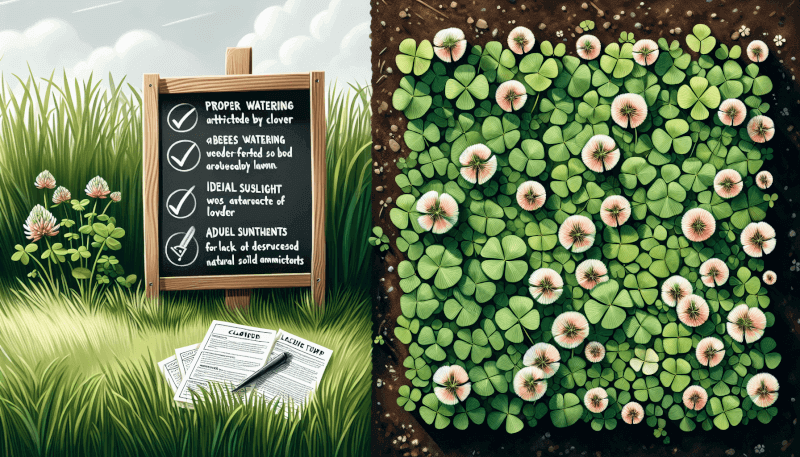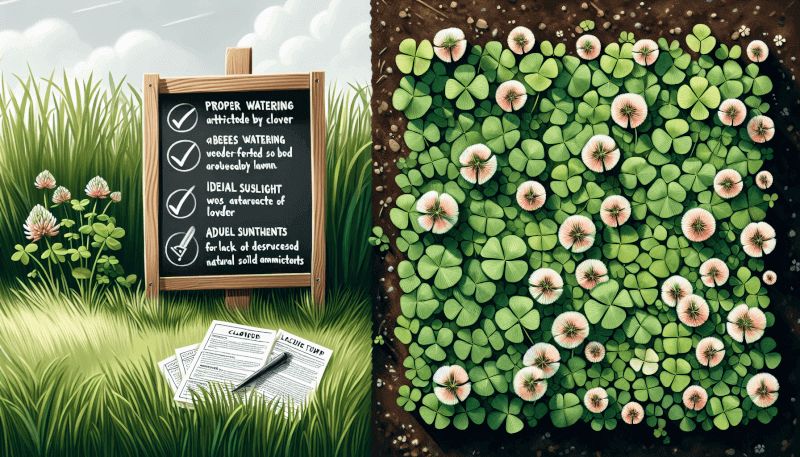If you’re looking to add a touch of green to your backyard or garden, growing clover might just be the perfect solution. Clover, with its vibrant foliage and delicate flowers, is not only a visually appealing addition to any landscape, but it also offers numerous benefits. From enriching the soil and attracting beneficial insects to providing a natural source of nitrogen, this versatile plant has it all. Whether you’re a seasoned gardener or a beginner, this article will provide you with all the essential tips and tricks on how to successfully grow and care for clover in your own space. So, roll up your sleeves and get ready to witness your garden flourish with this charming and beneficial plant!

Choosing the Right Clover Variety
When it comes to choosing the right clover variety for your needs, there are a few factors to consider. One of the most important aspects is the climate in your region. Different clover varieties thrive in different climates, so it’s essential to select one that is well-suited to your specific area. Additionally, you should assess the soil type in your garden or field. Some clover varieties prefer well-draining soil, while others can tolerate more moisture. Finally, think about the purpose of the clover. Are you looking to grow it for livestock feed, soil improvement, or as a cover crop? Different varieties have varying benefits and uses, so take this into account before making your selection.
Preparing the Soil
Before sowing clover seeds, it’s crucial to prepare the soil properly. Testing the soil pH is a crucial step, as clover prefers slightly acidic to neutral soil. You can easily conduct a soil test using a DIY kit or by sending a sample to a local agricultural extension office. If the pH is too low or too high, you may need to amend the soil using lime or sulfur to adjust the acidity level. Additionally, consider adding organic matter to improve the soil structure and provide essential nutrients for the growing clover. Compost or well-rotted manure are excellent options for adding organic matter to the soil. Lastly, choosing the right fertilizer is key. Opt for a balanced fertilizer with equal amounts of nitrogen, phosphorus, and potassium to ensure healthy clover growth.
Sowing Clover Seeds
Once you’ve prepared the soil, it’s time to sow the clover seeds. The appropriate time for planting varies depending on your location and climate. Generally, early spring or late summer are ideal times for sowing clover seeds. Before planting, make sure to prepare the seeds properly. Some varieties may require scarification, which is the process of breaking or weakening the seed coat to promote germination. You can achieve this by soaking the seeds in water for a few hours or nicking the seed coat with a file. Next, choose the sowing method that best suits your needs. Broadcasting the seeds by hand is a common method for larger areas, while using a seed spreader or a seed drill may be more efficient for larger-scale plantings.
Caring for Clover Plants
Proper care is essential for the healthy growth of clover plants. Adequate watering is crucial, especially during dry periods. Clover generally requires about an inch of water per week, so monitor soil moisture levels and adjust your watering accordingly. Be careful not to overwater, as clover is susceptible to root rot in excessively wet conditions. Additionally, regular weeding is necessary to keep the area around the clover plants free from competition. Remove any weeds by hand or use appropriate weeding tools, ensuring you do not damage the clover plants. Lastly, it’s important to stay vigilant and control pests and diseases that may affect the clover. Consult with local agricultural experts to identify and address any issues that arise.
Harvesting Clover
Knowing when to harvest clover is crucial to maximize its benefits. The right time for harvesting depends on the purpose of the clover. If you are growing it for livestock feed, it’s best to cut the clover when it is in the early bloom stage, as it offers the highest nutritional value. For soil improvement or cover crop purposes, you may allow the clover to grow until it reaches the late bloom or seed pod stage. Different cutting techniques are employed for different purposes. For livestock feed, mow the clover plants about two inches above the ground. If you’re using the clover as a cover crop, mow it as close to the ground as possible. Once harvested, you can dry the clover by spreading it in a thin layer and storing it in a cool, dry place.
Rotating Clover with Other Crops
Crop rotation offers numerous benefits for soil health and pest management. When considering rotating clover with other crops, it’s essential to choose compatible plants that have different nutrient and moisture requirements. This helps prevent nutrient depletion and decreases the likelihood of diseases and pests that target specific crops. Creating a crop rotation plan can ensure the optimal use of your land and promote overall sustainability. It’s advisable to rotate clover with crops such as corn, soybeans, or small grains, as they complement each other well. By practicing crop rotation, you can reduce the reliance on chemical inputs and create a more balanced and resilient farming system.
Common Mistakes in Growing Clover
While growing clover can be relatively straightforward, it’s important to avoid common mistakes that can hinder its growth. Planting the seeds too deeply is a common error. Clover seeds should be sown at a shallow depth of about ¼ to ½ inch. Planting them too deeply can prevent proper germination and result in weak or stunted plants. Proper watering is also crucial. Overwatering can lead to root rot and other issues, while under watering can cause stress and hinder growth. Find the right balance by observing the soil moisture levels and adjusting your watering schedule accordingly. Neglecting weed control is another mistake to avoid. Weeds can compete with clover for resources, so regularly check and remove any unwanted plants to ensure healthy clover growth.
Uses of Clover
Clover offers several uses and benefits, making it a versatile plant to grow. One of the most common uses is as livestock feed. Clover is highly nutritious and is a popular choice for grazing animals such as cows, goats, and horses. It provides essential vitamins and minerals, contributing to the overall health of the animals. Additionally, clover acts as a natural soil improver. Its deep root system helps break up compacted soil, improving its structure and aeration. Nitrogen-fixing bacteria present in clover roots also add nitrogen to the soil, benefiting other plants in the vicinity. Lastly, clover is often grown as a cover crop to protect the soil from erosion, suppress weeds, and enhance overall soil fertility.
Clover as a Wildlife Habitat
Growing clover can also benefit wildlife by creating a diverse and thriving habitat. Clover attracts beneficial insects such as bees and butterflies, which are important pollinators for various plants. By providing a food source for these insects, you contribute to the health and diversity of the ecosystem. Additionally, clover offers food for wildlife such as deer, rabbits, and birds. The flowers and seed pods of clover are rich in nutrients and provide a valuable food source, especially during the colder months when natural food is scarce. By cultivating clover, you can contribute to the creation of a vibrant wildlife habitat and add beauty to your outdoor space.
Closing Thoughts
Growing clover can be a rewarding experience, offering a range of benefits for livestock, soil health, and wildlife. By choosing the right variety, preparing the soil properly, and providing adequate care, you can ensure the successful growth of clover in your garden or field. Remember to consider the climate, soil type, and purpose of the clover before making your selection. With proper attention and maintenance, you’ll be able to enjoy the advantages of clover, whether as a livestock feed, soil improvement tool, or habitat for wildlife. So get started on your clover-growing journey and watch as your garden or field thrives with this versatile and valuable plant. Happy growing!




